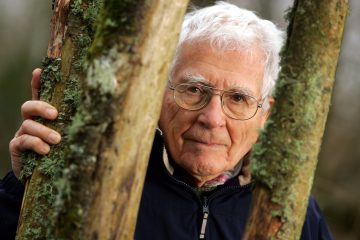Table of Contents
- Understanding James Lovelocks Gaia Theory and Its Impact on Ecology
- Ecological Innovations: The Legacy of James Lovelocks Scientific Contributions
- Climate Change Solutions Inspired by Lovelocks Vision of a Resilient Planet
- The Role of Technology in Ecological Preservation According to Lovelock
- Practical Steps for Embracing Lovelocks Ecological Principles in Daily Life
- Q&A
- In Conclusion

Understanding James Lovelocks Gaia Theory and Its Impact on Ecology
The concept of Gaia, as proposed by James Lovelock, revolutionizes our perception of the Earth as a dynamic, self-regulating entity. Lovelock’s theory posits that the biosphere, geosphere, and atmosphere interact in such a way that they maintain conditions conducive for life. This view shifts the paradigmatic understanding of ecology, which traditionally focused on organisms in isolation or in competition, to one where the Earth functions as an interconnected system. The implications of this holistic perspective encourage a deeper appreciation of how various elements—plants, animals, air, water, and soil—are interdependent.
One of the significant impacts of Gaia theory on ecology is the emphasis on feedback loops and resilience within ecosystems. Lovelock highlighted how natural systems can adapt to changes and disturbances through complex relationships. For instance, when one species changes its behavior or population dynamics, it triggers responses throughout the ecosystem that can stabilize or destabilize various elements. This understanding is critical in the context of environmental changes, whether they arise from human influence or natural phenomena. By recognizing these intricate relationships, ecologists can develop more effective conservation strategies and sustainable practices.
Furthermore, Gaia theory has fostered interdisciplinary collaboration between ecologists, climatologists, and social scientists, enhancing our collective ability to tackle global challenges such as climate change and biodiversity loss. Addressing these issues requires synchronized efforts, including but not limited to:
- Policy Development: Creating regulations that protect ecosystems while encouraging sustainable development.
- Educational Initiatives: Raising awareness about the importance of ecological balance.
- Scientific Research: Supporting studies that explore the interconnectivity of natural systems.
In essence, the Gaia theory not only champions a profound understanding of ecological relationships but also emphasizes our responsibility towards preserving the planet’s health, making it a cornerstone of modern ecology.

Ecological Innovations: The Legacy of James Lovelocks Scientific Contributions
James Lovelock, a visionary scientist, is best known for his groundbreaking work on Gaia theory, which posits that the Earth functions as a self-regulating system. His contributions have ignited discussions on ecological balance and the interconnectedness of life, fundamentally changing how we view our relationship with nature. Lovelock’s insights challenge us to rethink the impact of human activities on Earth’s systems and emphasize the importance of sustainability in our practices.
Among Lovelock’s notable innovations is the creation of the Electron Capture Detector (ECD), a sensitive instrument that detects trace gases in the atmosphere. This pioneering device was instrumental in identifying pollutants and monitoring climate change, shaping how researchers understand atmospheric chemistry. Through his work, we have gained invaluable data on greenhouse gas concentrations, which underpins policy decisions aimed at mitigating climate change and fostering ecological resilience.
Moreover, Lovelock’s advocacy for alternative energy solutions has paved the way for eco-friendly technologies. He has consistently argued for the integration of renewable energy sources into our daily lives, reinforcing the idea that technological advancements should align with ecological principles. His efforts underline the following key approaches to ecological innovation:
- Investment in Renewable Energy: Promoting solar, wind, and geothermal energy as sustainable alternatives.
- Research and Development: Encouraging scientific exploration of new eco-technologies.
- Public Awareness: Educating communities about the importance of environmental stewardship.
Climate Change Solutions Inspired by Lovelocks Vision of a Resilient Planet
At the heart of Lovelock’s vision lies the concept of Gaia, which posits that Earth operates as a self-regulating entity. This holistic approach to ecology encourages innovative thinking about climate change solutions. By recognizing the interdependence of all life forms and their environments, we can adopt strategies that enhance resilience and sustainability. Some potential solutions inspired by this vision include:
- Restorative Agriculture: Implementing practices that regenerate soil health and increase biodiversity, such as agroforestry and permaculture.
- Renewable Energy Adoption: Transitioning to solar, wind, and hydroelectric power sources to reduce reliance on fossil fuels and lower carbon emissions.
- Urban Rewilding: Creating green urban spaces to support local ecosystems, improve air quality, and enhance community well-being.
Lovelock emphasizes the importance of adaptive strategies in response to climate change. This means developing solutions that can evolve alongside our understanding of environmental challenges. For instance, the integration of technology is vital in achieving resilient ecosystems. Key areas for innovation include:
- Climate Smart Technologies: Utilizing AI and data analytics to monitor environmental changes and predict shifts in climate patterns.
- Carbon Capture Solutions: Investing in direct air capture and carbon storage technologies to actively remove CO2 from the atmosphere.
- Sustainable Water Management: Implementing advanced irrigation systems that conserve water while supporting agricultural productivity.
Moreover, education and community engagement play crucial roles in fostering collective responsibility toward environmental stewardship. Initiatives can support a grassroots movement focused on tackling climate change. These could include:
- Public Awareness Campaigns: Informing communities about their carbon footprint and actionable ways to reduce it.
- Participatory Projects: Involving local populations in decision-making processes for environmental projects to ensure their needs and insights are prioritized.
- Knowledge Sharing Platforms: Creating forums for exchanging successful sustainability practices among different communities.

The Role of Technology in Ecological Preservation According to Lovelock
James Lovelock, the renowned environmental scientist and originator of the Gaia hypothesis, emphasizes the profound impact that technology can have on ecological preservation. Embracing a synergistic relationship between technology and nature is crucial in addressing the pressing environmental challenges of our time. Lovelock argues that rather than viewing technology as an adversary to the natural world, we should harness its potential to foster sustainability and restore ecological balance.
Key technological innovations pointed out by Lovelock include:
- Renewable Energy Sources: Harnessing solar, wind, and tidal energies reduces dependency on fossil fuels and minimizes greenhouse gas emissions.
- Bioremediation Techniques: Using living organisms to clean up polluted environments showcases the potential of biotechnology in restoring ecosystems.
- Smart Agriculture: Precision farming and biotechnology enable more efficient use of resources, reducing waste and enhancing crop yields while preserving biodiversity.
Furthermore, Lovelock highlights the importance of using technology for monitoring and research purposes. By implementing advanced satellite imaging and data analytics, we can gain valuable insights into climate patterns and biodiversity dynamics. The integration of technology serves not only to enhance our understanding of ecological systems but also to develop proactive strategies for conservation. With innovative solutions at our fingertips, the potential for a sustainable future can be realized through thoughtful application of our technological advancements.

Practical Steps for Embracing Lovelocks Ecological Principles in Daily Life
Integrating Lovelock’s ecological principles into your daily routine can foster a deeper connection to the planet while promoting sustainability. To start, evaluate your consumption habits. This could mean reducing reliance on single-use plastics and opting for biodegradable alternatives. Consider making small swaps in your home, such as using glass containers instead of plastic, or purchasing items with minimal packaging. These changes collectively contribute to a healthier ecosystem.
Another essential practice is cultivating awareness of local ecosystems. By engaging in community initiatives focused on conservation, you can contribute to the stewardship of native habitats. Explore opportunities with local environmental groups or participate in citizen science projects that monitor wildlife and ecosystems. This active involvement not only bolsters your ecological knowledge but also fosters a sense of responsibility towards preserving biodiversity.
adopting a sustainable lifestyle can significantly impact your carbon footprint. Aim to reduce energy consumption by utilizing Energy Star appliances and incorporating smart home technology to optimize usage. Transportation also plays a crucial role; consider walking, biking, or using public transit whenever possible. If you drive, look into electric or hybrid vehicles as an eco-friendly alternative. Each intentional choice you make contributes to a larger movement towards ecological harmony.



0 Comments